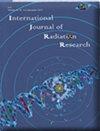Increased second primary liver cancer risk in young breast cancer patients undergoing radiotherapy and chemotherapy: a nationwide population-based study
IF 0.4
4区 医学
Q4 RADIOLOGY, NUCLEAR MEDICINE & MEDICAL IMAGING
引用次数: 0
Abstract
Background : Although chemotherapy (CT) and radiotherapy (RT) are important breast cancer (BC) treatment modalities, they can cause other cancers. However, second cancers of liver and stomach tend to be ignored during BC treatment. In this study, the incidence patterns of second primary cancer of liver and stomach were analyzed. Materials and Methods : The insurance claim data of patients that underwent definitive surgery from 2009 to 2010 were analyzed. Standardized incidence ratios (SIRs) were used to estimate the relative risks of second primary liver cancer (SPLC) and second primary stomach cancer (SPSC). In addition, hazard ratios (HRs) of risk factors were analyzed. Data were obtained on 21,024 BC patients that underwent definitive mastectomy. Results : The median follow - up period was 105.5 months. Overall SIRs for SPLC and SPSC were 7.26 (p<0.01) and 2.92 (p<0.01). In the young age group (aged 20–39 years), the crude HR for CT was 2.27 (p < 0.05) and the age/RT adjusted HR was 2.37 (p<0.05). RT also showed a tendency to induce SPLC. The effect of CT peaked within 5 years after treatment, whereas the effect of RT gradually increased after 5 years. Conclusion : This study shows CT and RT both increase the risk of SPLC in BC patients and that these increases are greater in young BC patients. Times to SPLC occurrence after RT and CT were found to differ.在接受放疗和化疗的年轻乳腺癌患者中,第二原发性肝癌的风险增加:一项基于全国人群的研究
背景:虽然化疗(CT)和放疗(RT)是重要的乳腺癌(BC)治疗方式,但它们可能导致其他癌症。然而,肝癌和胃癌在BC治疗中往往被忽视。本研究分析了肝癌和胃癌第二原发癌的发病规律。材料与方法:对2009 ~ 2010年行确定性手术患者的保险理赔资料进行分析。标准化发病率比(SIRs)用于估计第二原发性肝癌(SPLC)和第二原发性胃癌(SPSC)的相对风险。此外,还分析了各危险因素的风险比(hr)。数据来自于21,024例接受乳腺切除术的BC患者。结果:中位随访时间为105.5个月。SPLC和SPSC的总SIRs分别为7.26 (p<0.01)和2.92 (p<0.01)。年轻年龄组(20 ~ 39岁)CT粗HR为2.27 (p<0.05),年龄/RT校正HR为2.37 (p<0.05)。RT也有诱导SPLC的倾向。CT治疗的效果在治疗后5年内达到顶峰,而RT治疗的效果在治疗后5年内逐渐增强。结论:本研究显示CT和RT都增加了BC患者发生SPLC的风险,并且在年轻BC患者中增加的风险更大。发现RT与CT后发生SPLC的次数有差异。
本文章由计算机程序翻译,如有差异,请以英文原文为准。
求助全文
约1分钟内获得全文
求助全文
来源期刊

International Journal of Radiation Research
RADIOLOGY, NUCLEAR MEDICINE & MEDICAL IMAGING-
CiteScore
1.10
自引率
33.30%
发文量
42
期刊介绍:
International Journal of Radiation Research (IJRR) publishes original scientific research and clinical investigations related to radiation oncology, radiation biology, and Medical and health physics. The clinical studies submitted for publication include experimental studies of combined modality treatment, especially chemoradiotherapy approaches, and relevant innovations in hyperthermia, brachytherapy, high LET irradiation, nuclear medicine, dosimetry, tumor imaging, radiation treatment planning, radiosensitizers, and radioprotectors. All manuscripts must pass stringent peer-review and only papers that are rated of high scientific quality are accepted.
 求助内容:
求助内容: 应助结果提醒方式:
应助结果提醒方式:


